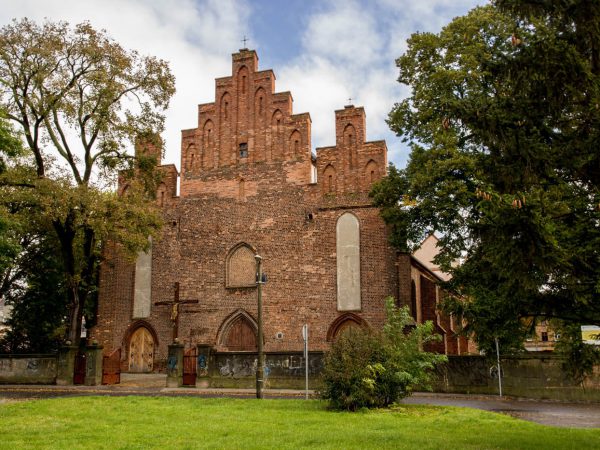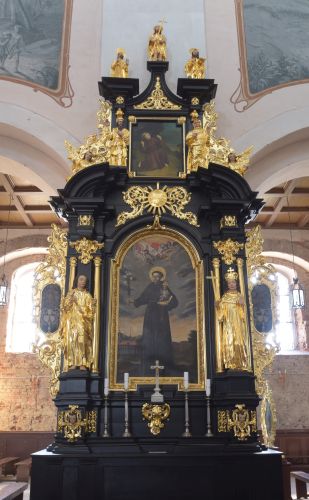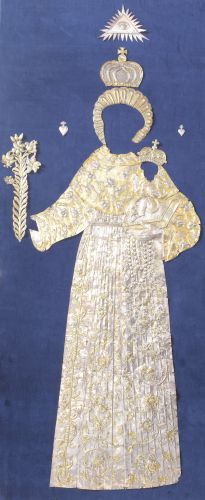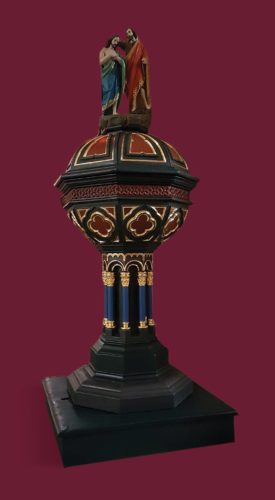
Monuments
Mystical Christ
In the centre of the Baroque side altar in the church of St. Nicholas there is a figure of the Crucified Christ which is almost 400 years older than the altar itself (it is dated to the half of the 14th century). It was adorned with the cityscape of Jerusalem made of silvered metal sheet with ornamental asymmetric flower motifs also made of metal sheet. These elements were created in the second half of the 18th century.
Christ Crucified represents a stylistic form of so called mystic type. Not uniform in style, sculptured in such a way that in some places is incorrect in regard to human anatomy (eg. the pattern of ribs is not accurate), it shows a special moment. It is the moment of agony shown by a falling head with a subtle wince of pain and the weight of body supported by hands which are tense with visible tendons. The connection of suffering and acceptance of inevitable destiny, peace which emanates from the tortured body is linked with need for presentation of the human nature of Christ – suffering and reconciled with his sacrifice.

Protect our city
In the side altar there is a painting of Our Lady of Consolation. This is a copy of the paiting from the sanctuary in Borek Wielkopolski. In the second half of the 17th century a pilgrimage movement became strong there because the image of the Mother of God of Borek was famous for miracles and graces. Many copies were made then and placed in churches in the whole country, also in Inowrocław.
Above Mary’s image there is an inscription: „Regina Poloniae praesidium urbs nostra” – Queen of Poland, protect our city.
The miraculous painting depicts Mary’ torso – She is holding the Baby in the left hand and she is pointing at Him with her right hand, as if she was saying: “Go to Jesus, whatever he orders you to do, do it!”.

A prominent preacher
Another side altar shows the image of St. Anthony of Padua. He lived in the 13th century and became famous for passionate preaching when he called for conversion. He had a great memory, broad knowledge and a strong, clear voice. He was well understood not only by the Italians, but also by the Spaniards and the German. He was canonized a year after his death. He was buried in Padua in a church especially built for this purpose. His vocal cords which helped him to preach the glory of God have not decayed.
St. Anthony battled usury. During all his life he was poor and he cared for the poor that is why in our churches there are money boxes for the poor next to his images. In this respect the saint still cares for them.
The legend has it that he possessed the gift of bilocation (which means he could be in two places at a time) and that he read people’s hearts. He performed many miraculous healings from serious illnesses.
He is depicted with little Baby Jesus because according to legend one night Baby Jesus visited him, kissed him and assured of God’s love for him. In a short time he was pronounced a Doctor of the Church.



In order to protect the historical painting of St. Anthony, the silver dress has been hanged separately, which allowed to exhibit the two works in their full glory.
Baptizm in the Jordan river

Indispensable equipment of Catholic church is a baptismal font. The one in the church in Inowrocław is made of wood. It represents a goblet type baptismal font – its original elements are a bowl with a cover, the pillar and the foundation. A sculpture representing the scene of Christ’s baptism performed by John the Baptist was put on the top. The Gospel by St. Mark says: “John wore clothing made of camel’s hair, with a leather belt around his waist, and he ate locusts and wild honey. And this was his message: “After me comes the one more powerful than I, the straps of whose sandals I am not worthy to stoop down and untie. I baptize you with water, but he will baptize you with the Holy Spirit.” At that time Jesus came from Nazareth in Galilee and was baptized by John in the Jordan. Just as Jesus was coming up out of the water, he saw heaven being torn open and the Spirit descending on him like a dove. And a voice came from heaven: “You are my Son, whom I love; with you I am well pleased.”
In St. Nicholas church in Inowrocław Jan Kasprowicz, one of the greatest Polish poets, was baptized in 1860. He glorified the beauty of the landscape of the Kuyavia region where he was born and parts of his poems were written in a stylized regional dialect.

